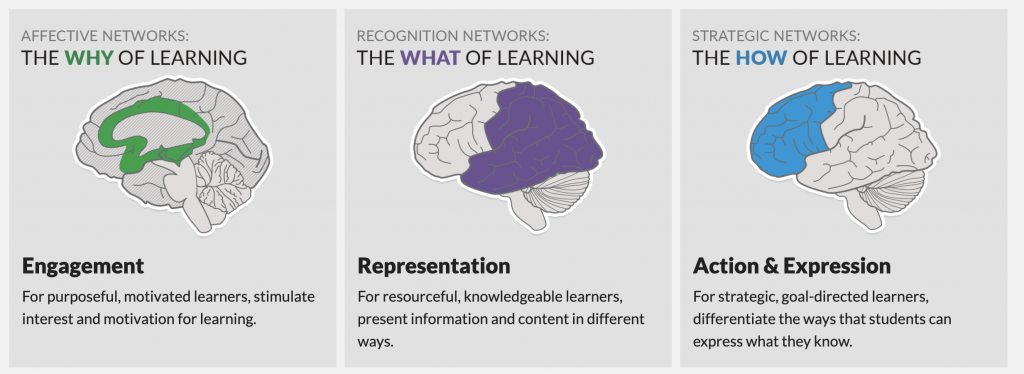
What is UDL?
UDL draws upon neuroscience and educational research to remove barriers and maximize learning for all students through a flexible curriculum. There are three primary principles of UDL:
-
-
- Provide multiple means of engagement: The variety of ways learners are engaged or motivated to learn.
- Provide multiple means of representation: The variety of ways that learners perceive and comprehend content that is shared with them.
- Provide multiple means of action and expression: The variety of ways that learners can navigate the learning experience and share what they know.
-
Image credit: CAST
For an overview of UDL guidelines, play the video below from the UDL Center at CAST
UDL Guidelines
The UDL Guidelines support the implementation of Universal Design for Learning. You can view the guidelines on CAST’s website opens in new window. Before you explore the guidelines, we recommend the overview below as an introduction to the structure of the guidelines.
Use the 3 links below to explore the guidelines for each principle in-depth through CAST’s website. Pay special attention to the descriptions for each guideline and the checkpoints provided. In the notes that you’re keeping for this course, record “sparks” or ideas that you have about incorporating the guidelines into the learning experiences you will develop.
- Provide multiple means of engagement
- Provide multiple means of representation
- Provide multiple means of action and expression
What does this mean for your teaching?
UDL provides you with multiple lenses for thinking through the learning experiences that you create for your students. While incredibly important in face-to-face and hybrid teaching environments, we would argue that UDL becomes critically important when we move into online environments so that we remember the variety of learner needs as we develop content and experiences. Since there is no one method that is optimal for all learners, you must remember to structure content delivery and demonstrations of understanding in a way that supports access to content and sharing through multiple means. If you think of it in terms of key questions to consider, we would suggest these:
-
- How will your learners experience the content?
- How will your learners contribute to the content?
- In what ways can your learners demonstrate their understanding?
Dig Deeper
Meyer and Gordon’s (2014) book, Universal design for learning: Theory and practice opens in new window is freely available through the CAST website opens in new window. if you’d like to explore UDL more deeply. All you have to do is create an account on the CAST website, in the upper right-hand corner of the page.